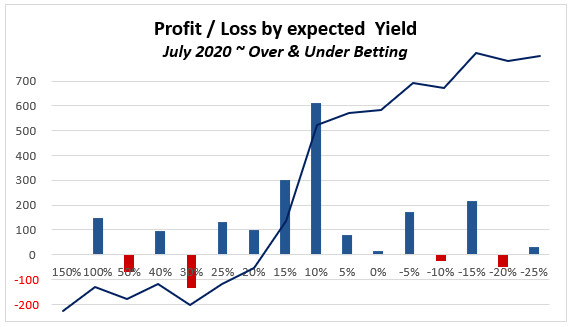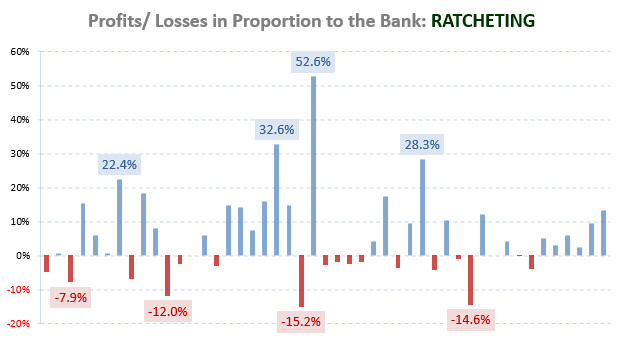
On 10 of the bets, the overround (profit margin) was between 6.28% and 38.89% (red).
Five bets were offered at negative ‘value’ which ranged between 4.31% and 16.21% (green):

(Swiss Cup, Scottish Cup, Champions League Final, Portuguese Cup, Coppa Italia, 2012)
Why do bookmakers love accumulators, multiples, or parlay bets?
In the article The Permutations of 5 Cup Finals in 5 Days I explained:
To compute the overall probability of a certain combination of results, simply multiply the individual probabilities together. Thus, the combined probability that all five favourites won was:
52.8% x 45.9% x 64.9% x 54.7% x 43.7% = 3.76% Effectively speaking, the 3.76% combined chance of all five favourites winning means this would statistically happen only once in every 25 seasons.
The above calculation is based on the REAL chances.
If you take Tipico’s probabilities (Table 3) then the equation is as follows:
The accumulator’s odds for all five favourites to win would have been (Table 1):
This means that a winning accumulator would have paid the bettor 17.63 times his stake as a return.
However, based on the true probabilities, all five favourites win only once in every 25 betting rounds (3.76%), which means that the bettor will lose his stake 24 times.
Winning 17.63 times his stake just once in 25 attempts is just not a prudent investment!
The overround (profit margin of the bookmaker) in this example is 42.8%:
Interpretation
The exponentiated overround for an accumulator as in this example (five-fold multiple bet on five favourites to win) gives the bookmaker a profit margin of more than 40%.
Of course it happens now and then that the bookmaker pays out, because a chance of 3.76% is not zero.
Tipico encourages accumulators by publishing daily lists of ‘lucky’ winners and the amounts they have won to encourage even more people to put their hard-earned cash into multiple bets, where the odds are definitely stacked in favour of the bookie.
Conclusion
Bookmakers just LOVE accumulators, multiple bets, and parlays, but people with dollar signs in their eyes continue to play..!
Amen.








After giving it some thought I am not sure if it is completely accurate. In one of your examples you say bookie has 6% overround and then compound it for accumulator and get 1.06 ^ 5 – 1= 33.8%. But bookie will only get 6% overround if its books are perfectly balanced. However I don’t see how bookies can balance accumulator bets, I mean so many different games involved in one bet. If they can’t balance accumulator bets, doesn’t it mean that the overround will be much lower, i.e. just from one outcome and not whole game?
Hi Eldar,
the overround increases as explained in the article and the likelihood to win the bet (accumulator) decreases hugely. Please see here an article on Combinatorics and Probability Theory in Football Betting
Bookmakers don’t balance bets in the way as it is widely believed by simply trying to sell the same amount of bets on each outcome. It’s far more complex.
If you haven’t bought the course book yet you may give it a thought to get it; in that I explain things like that (and many others) in great detail.
Should you be in doubt… here’s a recent comment from a German reader on the book (English readers unfortunately are spare in commenting on benefits once they bought a product)…
“As you say correctly, sports betting is and remains a risky affair with a lot of variables, the best course can’t change that. But thanks to your book “Fundamentals of Sportsbetting”, I now have some insight into how the bookmakers tick and can incorporate this knowledge into my bets.
Finally, I have to say that this was my best investment into betting in recent years.”
I did the math and if you have the edge on the bets in the accumulator (big if!) they can actually be slightly better than singles. However this is negated by the fact that with an acca you cannot pick and choose your odds like with singles. Hence I rarely use them except for fun.